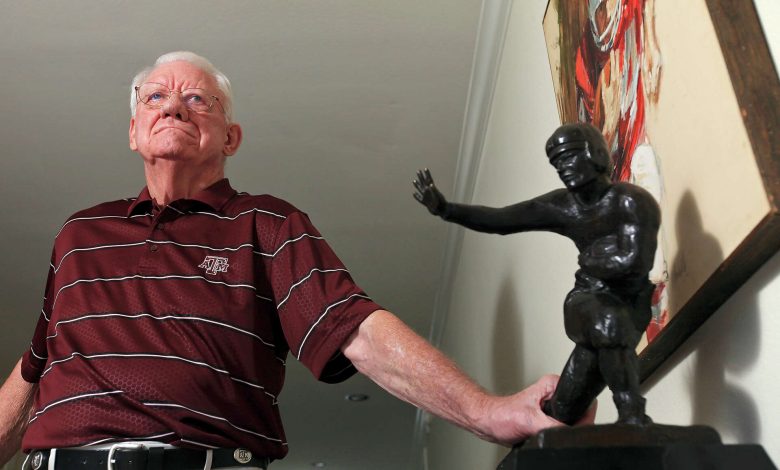A Deep dive into the legacy of John David Crow, Texas A&M Football’s first Heisman Trophy Winner.

John David Crow is a name that resonates deeply within the history of Texas A\&M University and the world of college football. As the university’s first Heisman Trophy winner, Crow’s legacy extends far beyond his achievements on the football field. His story is one of perseverance, dedication, and excellence—qualities that not only shaped the trajectory of Texas A\&M football but also left an indelible mark on the broader landscape of college athletics.
Born on July 8, 1935, in New Orleans, Louisiana, Crow was raised in a family where sports were an important part of life. He attended Woodlawn High School in Shreveport, Louisiana, where he first made a name for himself as a gifted athlete. His exceptional ability on the football field caught the attention of several college recruiters, but it was Texas A\&M University that ultimately won his commitment. This decision would go on to change not only Crow’s life but also the future of Texas A\&M’s football program.
Crow arrived in College Station in 1953 and quickly proved himself to be one of the most talented players the school had ever seen. He was a versatile athlete, playing multiple positions, including halfback, fullback, and quarterback. However, it was his role as a halfback that would come to define his college career. Under the guidance of legendary coach Bear Bryant, Crow’s skills flourished, and he quickly became the centerpiece of the Aggies’ offense. His natural athleticism, combined with his sharp football instincts, made him a force to be reckoned with on the field.
During his time at Texas A\&M, Crow was known for his explosive speed, powerful running style, and uncanny ability to break tackles. He was a true dual-threat, capable of rushing for long gains and also catching passes out of the backfield. His ability to make plays both on the ground and through the air made him one of the most dangerous offensive players in the country. However, what set Crow apart from many of his contemporaries was his leadership. He wasn’t just a star player; he was also the emotional leader of the team, inspiring his teammates to push beyond their limits.
In 1957, Crow’s exceptional play culminated in a historic achievement. That year, he was awarded the prestigious Heisman Trophy, given annually to the best player in college football. Crow became the first player in Texas A\&M history to receive the award, and his victory was a defining moment for the school’s football program. His performance that season was nothing short of spectacular. He rushed for 658 yards, scored 11 touchdowns, and helped lead the Aggies to a Southwest Conference title. Crow’s success on the field helped elevate Texas A\&M’s football program to national prominence and solidified his place in college football history.
But Crow’s legacy extends far beyond his individual accomplishments. He was a key figure in helping to establish the winning culture that would define Texas A\&M football for decades to come. His leadership on the field was matched by his leadership off it. Crow’s work ethic, discipline, and commitment to excellence became the standard by which future generations of Aggie football players would measure themselves. He was a model of consistency and professionalism, always giving his best in practice and games, and always holding himself and his teammates to the highest standards.
Crow’s impact on Texas A\&M was also felt in the way he helped to elevate the visibility of the university’s football program. His Heisman win put Texas A\&M on the national map, attracting top-tier recruits and raising the profile of the school’s athletic programs. His success gave the Aggies a sense of pride and purpose, and it provided the foundation for future generations of Texas A\&M athletes to build upon.
After graduating from Texas A\&M in 1958, Crow went on to have a solid professional career in the NFL. He was drafted by the Chicago Cardinals (now the Arizona Cardinals) in the second round of the 1958 NFL Draft and played for several teams over the course of his career, including the St. Louis Cardinals and the San Francisco 49ers. While his professional career was not as spectacular as his college career, Crow’s time in the NFL helped to further solidify his reputation as one of the most talented and versatile players of his era. He continued to be known for his leadership, work ethic, and determination, qualities that had defined him throughout his career.
In the years following his playing career, Crow remained closely connected to Texas A\&M and its football program. He became a prominent advocate for the university and its athletic department, using his platform to raise funds for scholarships, facilities, and programs that would benefit future generations of Aggie athletes. Crow’s passion for Texas A\&M was evident in his numerous contributions to the university, both on and off the field. He was a beloved figure among Aggie fans and players alike, and his influence on the program continued to be felt long after he had retired from professional football.
Perhaps one of the most enduring aspects of Crow’s legacy is the way he embodied the values of Texas A\&M. As a student-athlete, he exemplified the Aggie Code of Honor, which emphasizes integrity, respect, and personal responsibility. Crow’s commitment to these principles was evident not only in his play on the field but also in his personal life. He was known for his humility, sportsmanship, and dedication to service, qualities that made him a role model for aspiring athletes. His leadership and character were as integral to his success as his physical talents, and he continues to serve as a beacon for those who follow in his footsteps.
Crow’s legacy has been honored in numerous ways over the years. In 1990, Texas A\&M inducted him into the Texas A\&M Athletic Hall of Fame, cementing his place among the greatest athletes in the university’s history. His Heisman Trophy remains one of the most iconic and celebrated achievements in the history of the program, and his name is often mentioned in the same breath as other Texas A\&M legends such as Johnny Manziel, Gene Stallings, and Bear Bryant. Crow’s influence can still be felt in the culture of Texas A\&M football, where his impact continues to inspire current players and coaches alike.
Additionally, Crow’s influence extends beyond the football field and into the community. He has been involved in numerous charitable organizations and initiatives, using his success and platform to give back to others. His commitment to philanthropy and service has made him a respected figure not only in the world of sports but also in his community and beyond. Crow’s dedication to helping others and making a positive impact on the world around him reflects the core values that he held dear throughout his life.
Throughout his life, Crow remained deeply connected to his roots. He often spoke about how his upbringing in Louisiana and his time at Texas A\&M shaped his worldview and instilled in him the values of hard work, perseverance, and humility. His relationship with his teammates, coaches, and the Aggie community remained a central part of his identity, even after his playing days were over. Crow’s story is one of success, but it is also a story of commitment to something greater than individual achievement—a commitment to his team, his university, and his community.
In his later years, Crow was recognized with numerous accolades, including the Texas A\&M Distinguished Alumnus Award and a spot in the College Football Hall of Fame. These honors were a testament to his lasting impact on the sport and the university he loved so much. However, for Crow, the greatest reward was the knowledge that his efforts had helped shape the future of Texas A\&M football and had inspired generations of athletes to strive for excellence both on and off the field.
John David Crow’s legacy as Texas A\&M’s first Heisman Trophy winner is a legacy that will never be forgotten. His contributions to the program, his leadership, and his embodiment of the Aggie spirit have set the standard for all who have come after him. As the years pass, his name will continue to be synonymous with excellence, integrity, and the spirit of competition. Crow’s story is not just the story of one man’s remarkable achievements; it is the story of a program, a community, and a university that was forever changed by his influence.









